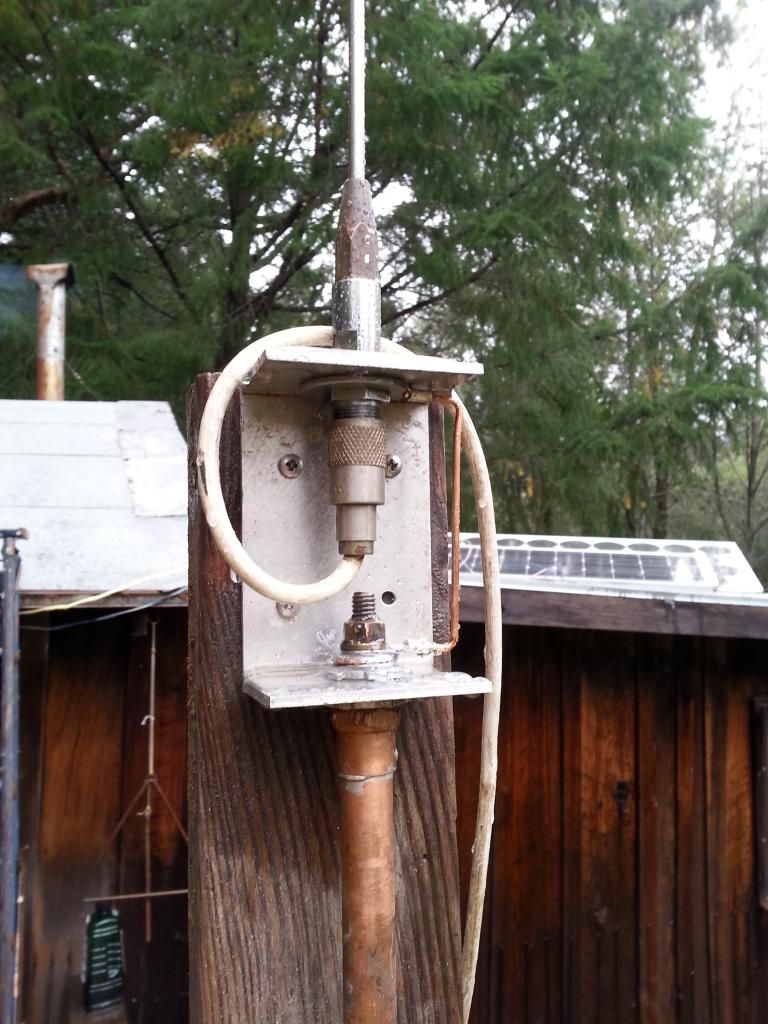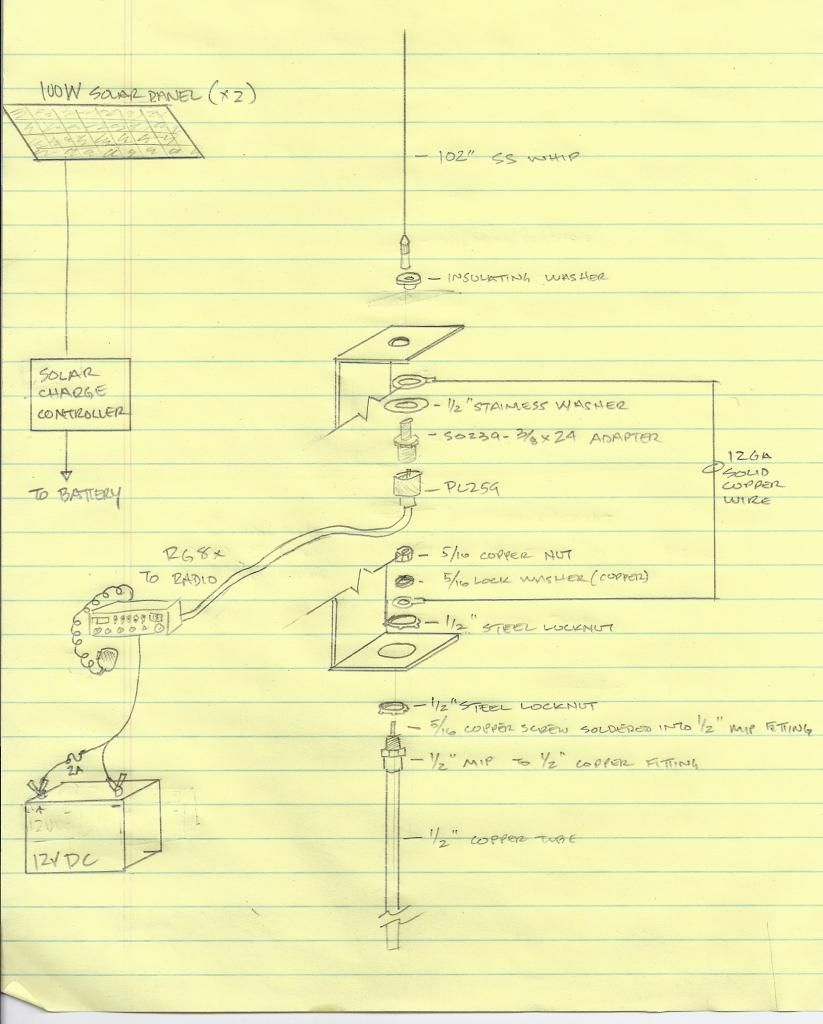mofugly13
Member
Hello all. I'm brand new here. I'm a rank amateur when it comes to radio tech. But I'm very mechanically inclined and like to build stuff myself whenever possible. Sooo...
I was hoping someone could help me out with a homebrew dipole antenna installation.
I have a hunting cabin in Northern Ca, and recently decided to set up a cb base station there mainly so I can communicate to the cabin from my hunting rigs from (almost) anywhere on the ranch. I have a CB already installed in my Samurai, and this weekend I tried to install a homebrew dipole on the cabin. After getting it installed, I had an SWR of 3:1 on both channels 1 and 40. Here's a photo of the antenna setup where the coax connects:

I'm hoping it's pretty self explanatory, but here's how I made it- I used a piece of aluminum channel and mounted a 102" stainless whip to the top using a PL259 antenna connector. For the counterpoise I used a piece of 1/2" copper tubing, 102" long, and it is secured to a threaded hole in the channel with lock nuts on either side to make good contact with the aluminum channel. Then, for good measure, I created a jumper from the PL259 connector shield to the copper pipe via a solid copper wire and a copper bolt I soldered into the end of the MIP-tubing adapter. I used anti-oxidant conductive grease on all the connections, making sure not to create a short between the ground and center conductor of the coax. Then there's about 22' of RG8x running to the cabin where I was attempting to use an old Cobra 29Plus as a base station.
At the cabin, there is extremely limited cell access, and therefore, no internet access, so on site troubleshooting was out. However after some reading and research today I think I have some potential issues, and it would be great if anyone who knows about these things could pitch in their 2 cents.
At the connection of the coax to the antenna, the coax runs down, parallel to the antenna for about 4' before it runs horizontally to the cabin. I think the coax needs to run horizontally directly from the connection at the antenna for a minimum distance before making any vertical turns?
My antenna is mounted on a post that stands about 7' off of the deck of the cabin, and therefore, my radio is mounted only about 3' vertically below the center connection of the antenna. Do I need to get the entire antenna up higher than the radio to get a better swr?
The cabin is built on a steep hillside, and where the antenna is right now, it's on the downhill side of the cabin and is at a higher elevation than 80% of the rest of the ranch. Rx is good, I took a ride in my Samurai, and called out different landmarks around the ranch as I got to them and my wife could read me loud and clear out to about 3.5 miles, which is as far as I went. However, due to the 3:1 swr and the fact that for some reason the Cobra 19plus would not transmit any sound, we couldn't do real-time radio checks. She just wrote down the landmarks as she heard them so I could see how far she could hear me.
What should I do to lower my swr?
I was hoping someone could help me out with a homebrew dipole antenna installation.
I have a hunting cabin in Northern Ca, and recently decided to set up a cb base station there mainly so I can communicate to the cabin from my hunting rigs from (almost) anywhere on the ranch. I have a CB already installed in my Samurai, and this weekend I tried to install a homebrew dipole on the cabin. After getting it installed, I had an SWR of 3:1 on both channels 1 and 40. Here's a photo of the antenna setup where the coax connects:

I'm hoping it's pretty self explanatory, but here's how I made it- I used a piece of aluminum channel and mounted a 102" stainless whip to the top using a PL259 antenna connector. For the counterpoise I used a piece of 1/2" copper tubing, 102" long, and it is secured to a threaded hole in the channel with lock nuts on either side to make good contact with the aluminum channel. Then, for good measure, I created a jumper from the PL259 connector shield to the copper pipe via a solid copper wire and a copper bolt I soldered into the end of the MIP-tubing adapter. I used anti-oxidant conductive grease on all the connections, making sure not to create a short between the ground and center conductor of the coax. Then there's about 22' of RG8x running to the cabin where I was attempting to use an old Cobra 29Plus as a base station.
At the cabin, there is extremely limited cell access, and therefore, no internet access, so on site troubleshooting was out. However after some reading and research today I think I have some potential issues, and it would be great if anyone who knows about these things could pitch in their 2 cents.
At the connection of the coax to the antenna, the coax runs down, parallel to the antenna for about 4' before it runs horizontally to the cabin. I think the coax needs to run horizontally directly from the connection at the antenna for a minimum distance before making any vertical turns?
My antenna is mounted on a post that stands about 7' off of the deck of the cabin, and therefore, my radio is mounted only about 3' vertically below the center connection of the antenna. Do I need to get the entire antenna up higher than the radio to get a better swr?
The cabin is built on a steep hillside, and where the antenna is right now, it's on the downhill side of the cabin and is at a higher elevation than 80% of the rest of the ranch. Rx is good, I took a ride in my Samurai, and called out different landmarks around the ranch as I got to them and my wife could read me loud and clear out to about 3.5 miles, which is as far as I went. However, due to the 3:1 swr and the fact that for some reason the Cobra 19plus would not transmit any sound, we couldn't do real-time radio checks. She just wrote down the landmarks as she heard them so I could see how far she could hear me.
What should I do to lower my swr?


